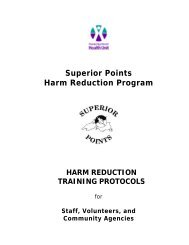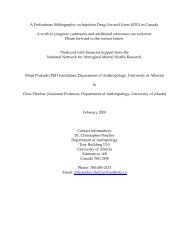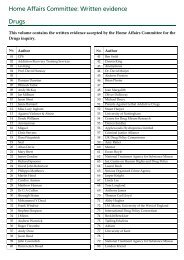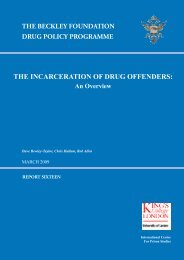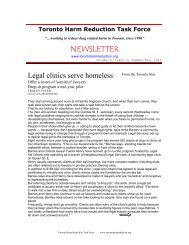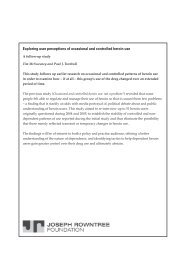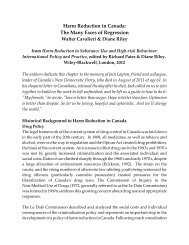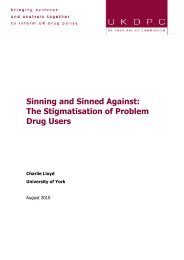and the building of the harm reduction-abstinence ... - ResearchGate
and the building of the harm reduction-abstinence ... - ResearchGate
and the building of the harm reduction-abstinence ... - ResearchGate
Create successful ePaper yourself
Turn your PDF publications into a flip-book with our unique Google optimized e-Paper software.
S.H. Kellogg / Journal <strong>of</strong> Substance Abuse Treatment 25 (2003) 241–247 243<br />
Table 2<br />
Typology <strong>of</strong> HR interventions<br />
Staying<br />
alive<br />
X<br />
X<br />
Designated Drivers<br />
Earlier Liquor Store Hours to<br />
Prevent Non-beverage<br />
Alcohol Consumption*<br />
Naloxone Distribution<br />
X<br />
Overdose <strong>and</strong> Safe Injection Information X<br />
Low Threshold Methadone Treatment X X<br />
Dance Drug/‘‘Ecstasy’’ Testing X X<br />
Safe Use/Injection Rooms X X<br />
Low Beverage Acohol* X X<br />
Maintaining<br />
health<br />
Getting<br />
better<br />
Safety Glassware in Bars*<br />
X<br />
Server Training*<br />
X<br />
Needle/Syringe Exchange<br />
X<br />
(Prevention Model)**<br />
Needle/Syringe Exchange<br />
X<br />
(X)<br />
(Risk Model)**<br />
Heroin Maintenance<br />
X<br />
Motivational Interviewing X X<br />
Harm Reduction Psycho<strong>the</strong>rapy X X<br />
Medium/High Threshold<br />
X<br />
X<br />
Methadone Treatment<br />
Motivational Interviewing X X<br />
Acupuncture <strong>and</strong> Herbal Treatments X X<br />
Substance Use Management X X<br />
Moderation Interventions X X<br />
Acupuncture <strong>and</strong> Herbal Treatments X X<br />
Drop-in Centers X X<br />
Harm Reduction Psycho<strong>the</strong>rapy<br />
X<br />
Buprenorphine-Naloxone Treatment<br />
X<br />
Naltrexone (Alcohol)<br />
X<br />
St<strong>and</strong>ard Methadone Treatment<br />
X<br />
Contingency Management Approaches<br />
X<br />
Based on Gradual Use Reduction<br />
Drug <strong>and</strong> Alcohol Education X X X<br />
* Single (1997).<br />
** Strike, Myers, & Millson (2002).<br />
Harm <strong>reduction</strong> interventions for <strong>the</strong> first group would<br />
primarilybeeducational(i.e.,DanceSafe,2003),butcouldalso<br />
include substance-use management interventions (Denning<br />
& Little, 2001; Marlatt, Larimer, et al., 1993; Moderation<br />
Management, 2003). The second group includes those who<br />
are not ready to change <strong>the</strong>ir use pattern because <strong>the</strong>y feel<br />
that <strong>the</strong>ir alcohol <strong>and</strong> drug use serves a purpose (Director,<br />
2002; Tatarsky, 1998, 2003). As Tatarsky (1998) noted,<br />
‘‘people use substances because <strong>the</strong>y address some psychological,<br />
social, or biological needs.... [<strong>and</strong>] substances may<br />
come to serve important psychological functions that help<br />
<strong>the</strong> user cope more effectively’’ (p. 11). In addition to coping<br />
<strong>and</strong> self-medication functions (Khantzian, 1985; Kohut,<br />
1977), <strong>the</strong> use <strong>of</strong> substances may be intimately connected<br />
with identities or relationships that appear to be central to <strong>the</strong><br />
person’s sense <strong>of</strong> self (Biernacki, 1986; Kellogg, 1993;<br />
Moore, 1990), <strong>and</strong> <strong>the</strong> discontinuation <strong>of</strong> use may result in<br />
<strong>the</strong> disruption <strong>of</strong> various social networks. Lastly, <strong>the</strong> prospect<br />
<strong>of</strong> treatment itself may appear to be unattractive (Denning,<br />
2001; Marlatt et al., 2001; Roche, Evans, & Stanton,<br />
1997; Springer, 2003; Westermeyer, 2003b).<br />
In terms <strong>of</strong> intervention, patients in this group could be,<br />
<strong>and</strong> frequently are, understood within a stages <strong>of</strong> change<br />
model (Denning & Little, 2001; Prochaska et al., 1992;<br />
Springer, 2002), <strong>and</strong> Motivational Interviewing is a recommended<br />
technique (Denning, 2001; Denning & Little, 2001;<br />
Miller et al., 1995; Springer, 2003; Westermeyer, 2003a).<br />
The purpose <strong>of</strong> <strong>the</strong> encounter would be to help <strong>the</strong>m move<br />
along <strong>the</strong> continuum toward taking some kind <strong>of</strong> action. A<br />
psycho<strong>the</strong>rapeutic intervention might be focused on discerning<br />
<strong>the</strong> personal meaning <strong>and</strong> symbolism <strong>of</strong> <strong>the</strong> drug use,<br />
evaluating <strong>the</strong> cost-benefit analysis involved in <strong>the</strong> decision<br />
to keep using (Tatarsky, 1998), underst<strong>and</strong>ing <strong>the</strong> relationship<br />
between trauma <strong>and</strong> substance use (Springer, 2002,<br />
2003), clarifying <strong>the</strong>ir drug-related identities <strong>and</strong> social networks<br />
(Biernacki, 1986; Kellogg, 1993), <strong>and</strong> underst<strong>and</strong>ing<br />
<strong>the</strong>ir conception <strong>of</strong> <strong>the</strong>ir personal life alternatives.<br />
In contrast, <strong>the</strong> third group consists <strong>of</strong> those who are<br />
‘‘unable’’ to stop. To see people as being unable to stop leads<br />
to what might be called <strong>the</strong> <strong>harm</strong> <strong>reduction</strong> <strong>of</strong> despair. In one<br />
approach, which humanistically emphasizes <strong>the</strong> needs <strong>of</strong><br />
<strong>the</strong>se terribly addicted users, <strong>harm</strong> <strong>reduction</strong> interventions<br />
may serve as a kind psychosocial hospice (see also Gelormino,<br />
2002); a way <strong>of</strong> ‘‘being with’’ people who are<br />
incurably ill, a way <strong>of</strong> walking with <strong>the</strong>m on a journey<br />
toward death. Ano<strong>the</strong>r approach, which takes more <strong>of</strong> a<br />
societal view, is to see <strong>the</strong>se highly addicted patients as a<br />
disease vector, be it for hepatitis C, HIV, or crime; here, <strong>the</strong><br />
emphasis becomes one <strong>of</strong> reducing <strong>the</strong> <strong>harm</strong> to <strong>the</strong> surrounding<br />
community. The covert (or not so covert) message,<br />
however, may be that <strong>the</strong>y no longer matter as individuals<br />
(Ibrahim, 1996).<br />
3. Harm <strong>reduction</strong> as a pathway to <strong>abstinence</strong><br />
Gradualism, which has a great deal in common with <strong>the</strong><br />
work <strong>of</strong> Marlatt (Marlatt, 1996, 1998a, 1998b; Marlatt &<br />
Kilmer, 1998; Marlatt, Larimer, et al., 1993; Marlatt, Somers,<br />
& Tapert, 1993; Marlett et al., 2001), seeks to create a<br />
continuum between <strong>the</strong> world <strong>of</strong> <strong>harm</strong> <strong>reduction</strong> interventions<br />
<strong>and</strong> <strong>the</strong> <strong>abstinence</strong>-oriented treatment field. Again, this<br />
approach differs from o<strong>the</strong>r calls for integration (Denning,<br />
2001; Marlatt et al., 2001) because <strong>the</strong>re is a much greater<br />
emphasis on making <strong>abstinence</strong> <strong>the</strong> eventual endpoint <strong>of</strong><br />
most <strong>harm</strong>-<strong>reduction</strong> enterprises. This paradigm would<br />
combine <strong>the</strong> <strong>harm</strong> <strong>reduction</strong> emphases on outreach to <strong>the</strong><br />
addicted, incremental change, <strong>and</strong> gradual healing with <strong>the</strong><br />
<strong>abstinence</strong>-oriented <strong>the</strong>rapeutic perspective that <strong>the</strong> use <strong>of</strong><br />
substances in an addictive or abusive manner is anti<strong>the</strong>tical<br />
to <strong>the</strong> growth <strong>and</strong> wellbeing <strong>of</strong> humans. As will be discussed<br />
below, this also means using <strong>the</strong> full compendium <strong>of</strong><br />
recovery oriented interventions. Instead <strong>of</strong> being an <strong>abstinence</strong>-only<br />
model, this combined approach could best be<br />
understood as an ‘‘<strong>abstinence</strong>-eventually’’ model.




